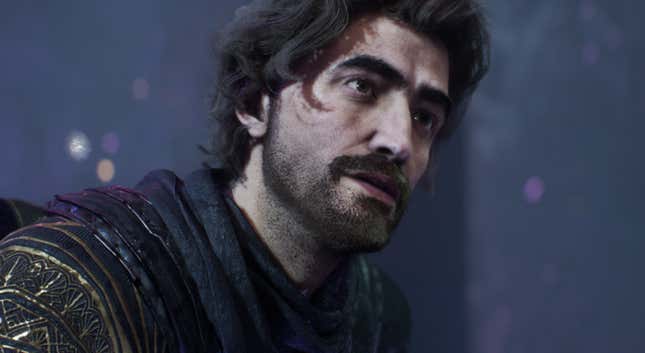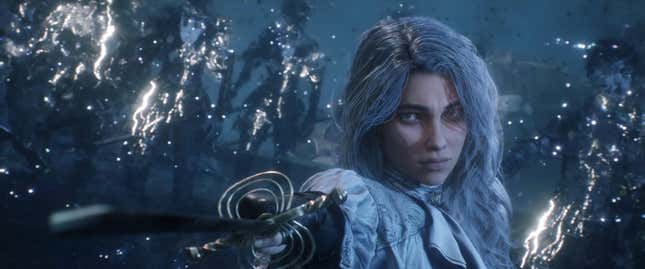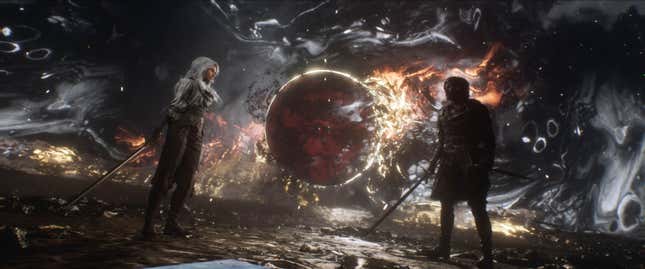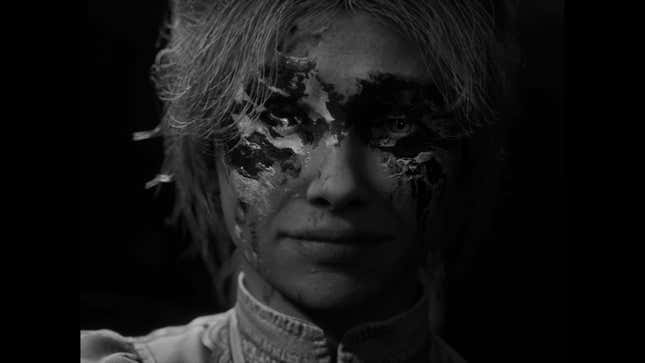
I’ve already written about Clair Obscur: Expedition 33’s wonderful homage to classic turn-based RPGs, and how it gives me a feeling most RPGs haven’t given me in a while. Its economy with scale, complex and rewarding systems, and the feel-it-in-your-bones melodrama makes even its most vicious moments hurt so good. If you’re looking for a broad recommendation on Sandfall Interactive’s debut project, then check out my review. What I haven’t gotten to write about is where it all leads. So if you’re done with the game or don’t mind spoilers, read on. For everyone else, I’ll see you in a brisk 30 or so hours.

Alright, are they gone? I gave them plenty of chances.
Clair Obscur: Expedition 33 endlessly defies what you expect it to be about. Sandfall Interactive’s favorite thing, other than making you sad with one of the most gut-wrenching RPG premises it could concoct, is twisting the knife and showing you nothing is as you believed. The game starts with the titular expedition group journeying beyond their island home in Lumière to defeat a god-like entity called the Paintress. Every year, she paints a number on a monolith visible from the island, and anyone of that age is “gommaged” from the world, disappearing in a cloud of petals. The knowledge that lives have a guaranteed expiration date has shaped the culture of this world. When people approach their final year, they join an expedition to hopefully stop the Paintress, or at least lay down the foundation for the next expedition to succeed. This has been going on for decades, and time is running out for the citizens of Lumière as the Paintress etches a “33” on the monolith. That’s where Clair Obscur starts, but I couldn’t have anticipated where it would end.
All three of Clair Obscur’s acts are punctuated with a game-shifting turn. At the end of the first act, Gustave, the grieving swordsman and gunslinger protagonist, is killed in cold blood. An incomprehensively old man named Renoir, who has somehow survived in a world where the life expectancy dwindles each year, is protecting the Paintress, and to do that, he kills your main character! The reins of this expedition are then handed to Verso, a man who is revealed to be the son of Renoir.. But this family drama goes far beyond a son trying to stop his father from killing expeditioners, and the consequences of this shift the entire world of Clair Obscur on its axis.

Ever more layers to this universe are revealed, and by the end of Act II, the scope widens to show you just how much bigger this tale is than the opening gambit of an expedition to stop the Paintress. It turns out the Paintress isn’t quite a god, but a woman who uses her family’s magic to “paint” worlds onto canvases that can bring whatever’s painted on them to life. She, her husband, and her children all wield this power and have created and explored different worlds inside these canvases throughout their lifetimes. This world, the one the expedition is trying to save, is the lone creation of the Paintress’ son, who died in a fire that left his sister scarred and the family broken. This world is all she has left of her son, and her unrelenting need to preserve it is consuming her.
Meanwhile, her husband (the real Renoir, on whom the fictional man who has been killing expeditioners is based) is trying to destroy this canvas so his family can try to move on. He wants his wife to be set free from this magical world of their son’s imagination, in which she is losing herself. The numbers the Paintress brushes on the monolith aren’t a signifier of the people she’s Thanos-snapping out of existence, but a warning that her power to defend the general populace is waning, and that as she loses her strength in this decades-long battle with her husband to preserve her son’s memory, the eldest among them will be the next to disappear.
This twist has been understandably divisive. Any time a story presents itself as one thing and reveals itself to be something else entirely, you run the risk of losing people brought in by the initial premise. However, I’m glad to report that at this point, I was more on board than ever. I’d already been locked in by Clair Obscur’s meditations on grieving a life you know you’ll never get to live. Grief is a cultural touchstone of this universe, and to find that it was all born of a mother’s loss of her child was an incredible new lens through which to view it. It’s revealed that all of this loss was not inevitable, and that the expedition’s fictional nature means that if they defeat Renoir and put an end to his gommage, they could potentially bring back everyone they lost. This adds new layers of nuance about how we keep someone’s memory alive when they’re gone, and how a creative work, even if it’s mostly a child’s fantasy, is one way to remember those we’ve lost. But again, this is Clair Obscur, and it always has another devastating trick up its sleeve.
The game’s final act lets you head right for the point of no return, to face Renoir, loosen his grip on this world, and bring back all the people he has gommaged over the past 67 years. By this point, you’ve learned that Verso is the fictional facsimile of the Paintress’ dead son. You’ve also found out that another of your party members, Maelle, is the Paintress’ real-life daughter, who entered the painting to find her missing parents, and instead found a new life in which she’s no longer debilitated by the damage from the fire. Verso now wants to tear down the canvas, so he can stop living as a puppet propping up his family’s memory of a son and brother long gone. However, Maelle wants to bring everyone back and live out her life in her brother’s creation. So it’s up to you, the player, to choose who to play as in one final battle and determine the fate of Verso’s canvas.

This was a decision so agonizing I had to put down my controller and make food, so I could give it proper thought. I was swayed to Verso’s side, until I returned and picked up the controller, when somehow my instincts took over, and I played as Maelle. Only, the ending I picked wasn’t quite what I envisioned. Rather than a bittersweet moment of Maelle bringing back all her brother’s creations and living happily ever after, what I experienced was more of a horror story. In this scenario, Maelle had trapped Verso in this world, forcing him to play piano for her and the rest of the revived Lumière.
I hadn’t perceived the game as setting up Maelle’s wishes to be a selfish path. I’d bought into the idea that saving the canvas and Verso’s memory was a noble choice worthy of the themes Clair Obscur had been operating within. But maybe that was me getting swept away by an idealistic view of this entire conflict. One of the only things that’s just as embedded in Clair Obscur’s DNA as grief is misdirection.
It’s been a few days since I finished Clair Obscur. I’ve been talking with others who have finished the game, and we’re all wrestling with the same questions of whether or not Sandfall Interactive truly stuck the landing. There are throughlines of grief in every new path it takes, but as the game shifts its themes, what it has to say about the process, the good and bad ways we deal with grief, and who was actually “right” in the surprising metatexual conflict, seems to shift as quickly as its inconsistent dodging windows. I’ve chewed on every possibility for days now, and part of me wonders if that dissatisfaction is just part of the process.

Maybe I’m grieving the happy ending I thought I was fighting for. Perhaps, after all the death and despair I saw in Clair Obscur, it was foolish to have been looking for one in the first place. Grief isn’t just mourning the loss of a person, it’s lamenting a life you imagined you’d have. Sometimes I wonder if coming out of the grieving process is in fact delusion. We have to explain to ourselves how something as senseless as death has meaning, or reassure one another that we’ll see those we’ve lost in whatever comes next. We tell ourselves whatever is necessary in order to feel somewhat okay again, even if it doesn’t quite make sense. But no matter how we bandage the wound, grief never entirely goes away. We just come up with whatever explanation helps us go on about our day. I feel like that’s where I’m at with Clair Obscur: Expedition 33. I’ve decided that its ending, my dissatisfaction with parts of it, and all the ways the conclusion subverted what I hoped for, was probably the point. I can stay in the denial phase a little bit longer.

